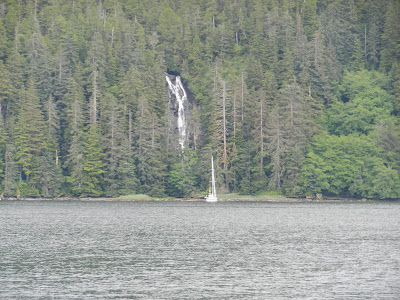 |
| Dorothy Narrows |
A new day and our next planned stop
was Goddard Hot Springs on Baranof Island located behind Eovoli Island, just an
hour’s motor away from Herring Bay through the inside passage of Dorothy
Narrows. We studied the charts and
description regarding transiting Dorothy Narrows, a passage lined with
submerged rocks requiring careful navigation.
The description was not completely clear as to which side of the green
channel marker we should pass, the marker being in the middle of the Narrows. We both concluded that reference was made to
favor the east side of the marker. We
slowly motored into Dorothy Narrows along the east shore and saw a fishing boat
coming from the opposite direction. He
too was keeping to the east side of the channel marker confirming that we had
chosen the correct side; when in doubt, watch the local traffic or ask a local
boater.
Once through the Narrows we
motored into Hot Springs Bay and anchored in front of the Hot Springs on
Baranof Island. A lovely spot but the
anchorage can be questionable so we took turns going ashore.
A boardwalk marks the way to the tubs, one
tub is located along the shore and the other tub up the hill.
Both tubs are enclosed by a wooden shelter
and are maintained by the U.S. Forest Service.
You can even regulate the temperature from warm to hot by using two
valves that supply spring water stored in tanks. An outflow pipe in the tub helps keep the
water clean.
We noticed that there were
names etched or penned on the sides of the walls around the tubs, of course we
had to add our boat name for posterity sake.
The best part about visiting here is the beautiful view from the tubs
overlooking the sea; and for many, a long relaxing soak can improve the skin
and relax the soul. After spending most
of the afternoon at the Hot Springs, we continued north passing Povorotni Point
and Cape Burunof.
The name Burunof comes
from the Russian mys burunof (cape of
breakers). We chose Samsing Cove on Baranof Island as our anchorage for the next couple of nights, conveniently located just four miles from Sitka.
 |
| Local Fisherman (east of the channel marker) |
 |
| Goddard Hot Springs, Hot Springs Bay |
 |
| Boardwalk along shore to Tub |
 |
| Boardwalk to upper Tub |
 |
| Hot Springs Tub |
 |
| View from Hot Springs Tub |
 |
| Artwork inside Hot Springs Tub Shelter |
 |
| Boat Name for posterity sake |
 |
| Afternoon Sun at Hot Springs Bay |








































